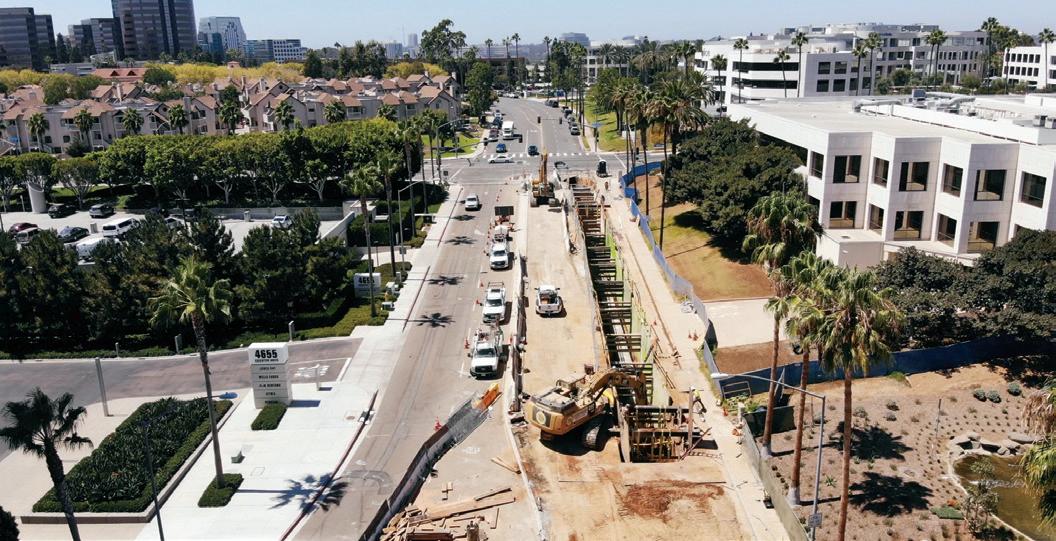
3 minute read
California Soars to New Heights with State-of-the-Art Airport Construction
In the early 20th century, the demand for air travel increased significantly, and with it came the need for a network of airports across the United States. California was at the forefront of this development, with its proximity to the Pacific Ocean and its status as a hub of industry and innovation. The first airport in California was established in 1917 in San Diego, primarily for military use during World War I. However, as the war ended and air travel became more accessible to the public, the airport was opened to civilian use, and it quickly became a popular destination for commercial flights.
The first official commercial airport in California was Grand Central Airport in Glendale. It offered the first paved runway west of the Rocky Mountains and served as the departure point for the nation’s first transcontinental airline service. As the popularity of air travel grew, the need for more airports in California became apparent. In 1923, the city of Los Angeles established the first municipal airport in the country, the Los Angeles Municipal Airport, which was later renamed LAX. This airport was located on the outskirts of the city, and its construction marked the beginning of a new era in air travel.
Over the next few decades, California continued to lead the way in airport construction, with the development of many new airports across the state. In 1928, the city of San Francisco established the San Francisco Municipal Airport, which would later become the San Francisco International Airport (SFO). This airport became an important hub for international travel, connecting California to destinations around the world. Another major airport that was established during this time was the Oakland Municipal Airport, which was built in 1927. This airport was initially used for mail and cargo transport, but it quickly became a popular destination for commercial flights as well.

As the demand for air travel continued to increase, the state of California began to invest in the construction of more airports. In 1935, the state government established the California Division of Aeronautics, which was tasked with overseeing the development of new airports across the state. One of the most significant airports to be constructed during this period was the Burbank-GlendalePasadena Airport, which was built in 1930. This airport quickly became an important hub for commercial flights, connecting California to destinations across the country. In the following years, many other airports were built across California, including the Long Beach Municipal Airport, the Santa Monica Municipal Airport, and the San Jose Municipal Airport. These airports were designed to accommodate the growing number of air travelers, and they played an important role in the economic development of the state. During World War II, many of these airports were used for military purposes, as the United States government relied heavily on airpower to win the war. However, after the war ended, these airports were once again opened to civilian use, and they continued to play an important role in the development of air travel in California.
Today, California is home to some of the busiest airports in the world, including Los Angeles International Airport (LAX), San Francisco International Airport (SFO), Oakland International Airport (OAK), San Diego International Airport (SAN), Sacramento International Airport (SMF), Bob Hope Airport (BUR), John Wayne Airport (SNA), and Ontario International Airport (ONT), along with many other smaller, regional airports across the state. These airports serve millions of passengers each year, connecting
California to destinations around the world. In recent years, there has been a renewed focus on airport construction in California, as the state seeks to address the challenges of climate change and reduce its carbon footprint. Many new airports are being built with a focus on sustainability and energy efficiency, using renewable energy sources and innovative design strategies to minimize their impact on the environment. State-of-theart airport construction techniques include advanced technologies such as Building Information Modeling (BIM), 3D printing, Prefabrication and Modular Construction, Virtual Reality (VR) simulations, and the use of sustainable and eco-friendly materials. These techniques improve efficiency, reduce costs, enhance safety, and minimize environmental impact, making them essential for modern airport development.
From the establishment of the first municipal airport in Los Angeles to the construction of some of the busiest airports in the world, California has been at the forefront of this development, leading the way in innovation and sustainability. Companies like Tutor Perini Corporation, Swinerton Builders, Turner Construction, Flatiron Construction, Skanska USA, PCL Construction, Clark Construction, Webcor Builders, Hensel Phelps Construction Co., and many others, have extensive experience and specialize in airport construction. This issue of CalContractor Magazine includes several articles featuring airport construction projects currently underway in California. As air travel continues to grow and evolve, the importance of state-of-the-art airport construction methods will only continue to increase, in order to continue providing that vital link between California and the rest of the world. Cc






